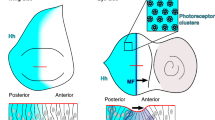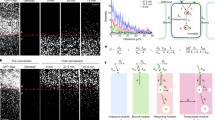Abstract
Responses of developing tissues to experimental disruption demonstrate that cell interaction is important both in generating positional information and in controlling growth1. However, the mechanism by which cells interact and the range over which the interactions are effective are not known. In the imaginai disks of Drosophila melanogaster, experiments on pattern regulation following surgical ablation suggest that the cell interactions are very local in nature; in fact, most of the data can be explained by assuming that cells interact only with their immediate neighbours2. In contrast, studies of cell division patterns in the same tissue indicate that the ‘local’ proliferative response to an ablation extends over a distance of up to about eight cell diameters3. Still longer-range interactions have been proposed on the basis of theoretical considerations4. It is possible that the interactions are mediated by the transfer of small molecules through gap junctions, as gap junctions are abundant in imaginai disks at the appropriate developmental stages5. We have explored the range, timing and directionality of dye coupling between the cells of the wing disk as a test of the possible role of gap junctions in imaginai disk patterning. Our results indicate that interactions over different ranges are possible depending on the nature of the molecule being transferred.
This is a preview of subscription content, access via your institution
Access options
Subscribe to this journal
Receive 51 print issues and online access
$199.00 per year
only $3.90 per issue
Buy this article
- Purchase on Springer Link
- Instant access to full article PDF
Prices may be subject to local taxes which are calculated during checkout
Similar content being viewed by others
References
French, V., Bryant, P. J. & Bryant, S. V. Science 193, 969–981 (1976).
Held, L. I., Jr & Bryant, P. J. in Pattern Formation: A Primer in Developmental Biology (eds Malacinski, G. M. & Bryant, S. V.) 291–322 (Macmillan, New York, 1984).
O'Brochta, D. A. thesis, Univ. California, Irvine (1984).
Meinhardt, H. in Pattern Formation: A Primer in Developmental Biology (eds Malacinski, G. M. & Bryant, S. V.) 47–72 (Macmillan, New York, 1984).
Ryerse, J. S. Wilhelm Roux Arch dev. Biol. 191, 335–339 (1982).
Stewart, W. W. Nature 292, 17–21 (1981).
Weir, M. P. & Lo, C. W. Devl Biol. 102, 130–146 (1984).
Garcia-Bellido, A., Ripoll, P. & Morata, G. Nature new Biol. 245, 251–253 (1973).
Brower, D. L., Lawrence, P. A. & Wilcox, M. Devl Biol. 86, 448–455 (1981).
O'Brochta, D. A. & Bryant, P. J. Nature 313, 138–141 (1985).
Weir, M. P. & Lo, C. W. Proc. natn. Acad. Sci. U.S.A. 79, 3232–3235 (1982).
Warner, A. E. & Lawrence, P. A. Cell 28, 243–252 (1982).
Blennerhassett, M. G. & Caveney, S. Nature 309, 361–364 (1984).
Bryant, P. J. J. exp. Zool. 193, 49–78 (1975).
Schubiger, G. Devl Biol. 26, 277–295 (1971).
Author information
Authors and Affiliations
Rights and permissions
About this article
Cite this article
Fraser, S., Bryant, P. Patterns of dye coupling in the imaginal wing disk of Drosophila melanogaster. Nature 317, 533–536 (1985). https://doi.org/10.1038/317533a0
Received:
Accepted:
Published:
Issue Date:
DOI: https://doi.org/10.1038/317533a0
This article is cited by
-
Connexins and pannexins in neuronal development and adult neurogenesis
BMC Cell Biology (2016)
-
Structure and function of gap junctions in the developing brain
Cell and Tissue Research (2006)
-
Lineage analysis of transplanted individual cells in embryos of Drosophila melanogaster
Roux's Archives of Developmental Biology (1987)
Comments
By submitting a comment you agree to abide by our Terms and Community Guidelines. If you find something abusive or that does not comply with our terms or guidelines please flag it as inappropriate.



